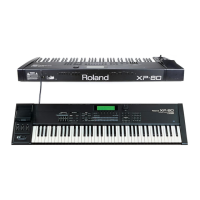®ÂØÒňΠXP-60/80 Supplemental Notes
© 1998 Roland Corporation U.S. XP-60/80 Advanced Sequencing Page 6 of 9
Create
You can create almost any type of MIDI message in this mode. Use the following procedure to create the note C4
n Pattern 001, MIDI channel 1, at measure 3 beat 1 (the same as in Fig. 1 on the previous page):
i
1) Press SEQUENCER followed by F4 (Micro).
2) Use the FWD/BWD buttons to locate to “3-01-000.”
3) Press the Pattern button and use the VALUE DIAL to select “Pattern 001” then press ENTER.
4) Press F1 (Create).
5) Use the VALUE DIAL to select “NOTE” and press F6 (Execute).
6) CURSOR to Ch and use the VALUE DIAL to select “1.”
7) CURSOR to Note and use the VALUE DIAL to select “60” (C4).
8) CURSOR to OnVel and use the VALUE DIAL to select “127.”
9) CURSOR to Gate and use the VALUE DIAL to select “192.”
10) CURSOR to OfV and use the VALUE DIAL to select “64.”
11) Press EXIT.
Move
Occasionally, you may wish to move a note to another location. Use the following procedure to move the note
message we just created to measure 4, beat 2:
1) Press SEQUENCER followed by F4 (Micro).
2) Use the UP/DOWN CURSOR buttons to select the C4 note to be moved.
3) Press F3 (Move).
4) Use the CURSOR buttons and the VALUE DIAL to select “04-02-000” for the time.
5) Press F6 (Execute) followed by EXIT.
Erase
You can also erase wrong notes. Use the following procedure to erase the note created above:
1) Press SEQUENCER followed by F4 (Micro).
2) Use the UP/DOWN CURSOR buttons to select the C4 note.
3
) Press F2 (Erase) followed by EXIT.
NOTE: You can use the UNDO button if you erase the wrong note or don’t like any edit done in Microscope Mode.
V. Editing Standard MIDI Files
What are Standard MIDI Files?
Standard MIDI Files (SMFs) are a specific file format for storing sequences. This format has been accepted by
almost all manufacturers and allows song files to be played back by a wide range of sequencers and instruments.
There are 2 formats for SMFs:
• SMF Type 0: All musical data is on one track. There is a second track for tempo and beat data.
• SMF Type 1: The musical data is saved on as many as 16 tracks with a 17
th
track for tempo and beat data.
What is General MIDI?
General MIDI is a standard developed to allow music to be created on one manufacturer’s instrument and to be
able to be played back on another manufacturer’s instrument easily. In order for an instrument to be “GM
compatible,” it must meet the following minimum specifications:
• 24-voice polyphonic
• 16-Part multitimbral
• 128 patches conforming to GM mapping ( i.e. 1=Piano 1, 17=Organ 1, etc.).
Roland has developed a format called GS which provides some additional flexibility in sounds and effects to the
GM specification. Standard MIDI Files that are developed for GM will playback correctly on GS instruments.
However, files that are developed for GS may not playback correctly on GM instruments.

